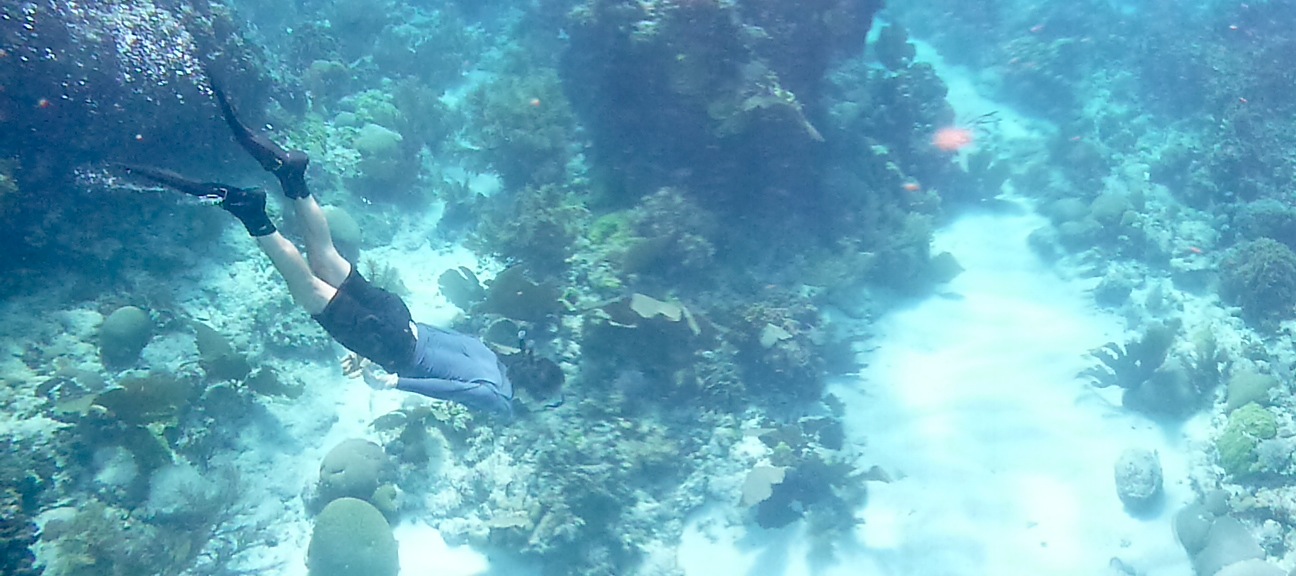
[The third installment in our New York Times “Scientist at Work” field log.]
Collecting shrimp is a complicated business. I am not as seasoned as my colleagues, but I quickly learn how tedious it can be. After taking a photograph and estimating the volume of a sponge, we have to locate every shrimp inside. Synalpheus have the amazing ability to wiggle their way into the sponge’s inner depths, making themselves very difficult to find. And they are not the only inhabitants of the sponge or coral rubble. We often find brittle stars, polychaete and fire worms, various tiny crustaceans, mantis shrimp and even the occasional octopus. Although some sponges are quite malleable, others are rubbery and difficult to pick apart. Reaching into the bags for rubble is like a carnival game. We all hope to avoid certain species of sponges that require more effort than others. Depending on the species, a sponge with the volume of a tennis ball could take 30 minutes or more to dissect. For some of the tougher species, we often use a serrated bread knife to carefully slice pieces of sponge, trying not to do the same to the shrimp.
Many species of sponge are quite painful to touch. The chemicals they exude can sting or itch for days. Others can leave dozens of tiny glass needles, called spicules, that make up their skeleton embedded in your fingers. Although others in our group prefer to wear gloves while dissecting sponges, I find them too restrictive. Needless to say, my hands will likely ache for the rest of the week, full of spicules, cuts and fire worm hairs. When we finally locate a Synalpheus shrimp, we delicately grasp it with forceps and place it in an individual plastic drinking cup to avoid damaging fights with others. After each piece of sponge is visually inspected, it is dipped in freshwater for a few seconds. If a Synalpheus manages to escape visual identification, it typically snaps its major chela, or snapping claw, after being immersed in fresh water. By the end of a session, maybe hundreds of shrimp each rest in its own plastic cup, occasionally snapping. We then return the coral rubble, and all the other creatures we found inside it, to the ocean.

Snapping shrimp get their name from their unusually large major chela, which they use to deter predators or other shrimp that compete with them for precious space within a sponge. Snapping their major chela produces a 60 mile-per-hour jet of water and shock wave that can stun or even kill other individuals. In its wake, the jet leaves a cavitation bubble that, when it collapses, produces a tiny burst of energy with temperatures reaching as hot as the surface of the sun. We know from captive experiments in the lab that shrimp will vigorously defend their sponges from invaders and we have observed on occasion one individual killing another with a single snap of the claw. Indeed, our working hypothesis is that the advantage of cooperative defense against competitors is a major driver of the evolution of social colonies among these reef shrimp. In some species of Synalpheus, colony defense is actually coordinated among group members and thus, there very well may be a soldier caste to defend the colony, much as there is in some ants and termites.
We sometimes think of Synalpheus shrimp as the termites of the marine world. As far as we know, they are the only highly social organisms in the marine environment, and perhaps the most socially diverse group of invertebrates, including the social insects. Synalpheus shrimp are similar to the familiar social insects in many ways. Not only are they invertebrates, but in some of the eusocial species, there appear to be the beginnings of distinct morphological or behavioral roles. At the same time, some Synalpheus species share characteristics with social vertebrates. For example, they have gradual development and the “workers” in social shrimp species are morphologically similar to reproductive individuals.
Our preliminary genetic and physiological work has demonstrated that family structure in some shrimp species resembles that of social insects, but in others it more closely mimics that seen in social birds and mammals. Additionally, unlike in most social insects, workers in some species appear to be fully capable of reproducing. With every collection of shrimp we make, we are learning more and more about these fascinating animals — and about fundamental principles of social biology and evolution.
Because they share characteristics with both social insects and social vertebrates, Synalpheus shrimp may uniquely allow us to test and compare some of the alternative explanations for the evolution of complex societies. For these reasons, sponge-dwelling shrimp offer an exciting prospect for joining the largely separate scientific traditions of vertebrate and insect social biology. Importantly, as a group, they are more socially diverse than most social insects. For example, all of the more than 10,000 species of ants are eusocial. Although bees exhibit a range of social behaviors as diverse as those observed in Synalpheus, the social differences evolved over long periods of time in very distantly related species. In contrast, we see the whole range of animal social systems within a group of approximately 40 species of closely related shrimp, a situation unique among all animals. Hopefully, with a bit more work in the lab and field, and a little more success sampling, we’ll soon be able to solve the mystery of social evolution in this fascinating group, with implications for animals generally and perhaps even our own species.

Leave a Reply